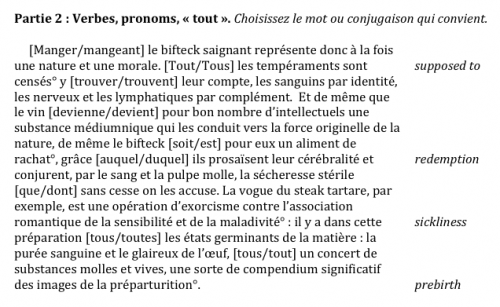 One difficult aspect of teaching grammar is the disjointed impression given by a series of grammar lessons: when going over the difference between the gerond and the infinitive, for example, we tend to give students a long series of sample sentences showing when one form is used rather than the other. When talking about imparfait vs. passé composé, we can take a story in the present tense and put it in the past, but we are still only focusing on the verbs while ignoring the rest. What about dissecting a “real” example to see how a variety of forms and structures are used?
One difficult aspect of teaching grammar is the disjointed impression given by a series of grammar lessons: when going over the difference between the gerond and the infinitive, for example, we tend to give students a long series of sample sentences showing when one form is used rather than the other. When talking about imparfait vs. passé composé, we can take a story in the present tense and put it in the past, but we are still only focusing on the verbs while ignoring the rest. What about dissecting a “real” example to see how a variety of forms and structures are used?
This kind of “real life” application of what we’d been studying is what my students specifically requested to conclude our summer writing course. They didn’t have trouble working on isolated sentences with contrived meaning, but putting them together or seeing grammatical forms used to express complex ideas was more difficult to accomplish. I thought first about coming up with my own text, but then realized that this was a great opportunity to familiarize students with authors or texts we didn’t have time to get to during the course. In this case, I chose Barthes‘ essay “Le Bifteck et les frites” from Mythologies (1957). Using the “table” tool in Microsoft Word, I split the text into sections with a narrow column on the right to offer translations of difficult words. For each section, I focused on a few different points: prepositions and pronouns; verbs, pronouns, the word “tout”; adjectives; verbs. Students worked on the text in partners.
Once we sorted out the grammar, we talked about meaning: Barthes’ comparaisons, the progression of the symbols used to express the cultural significance of steak and fries (looking thematically at each paragraph), the imagery evoked in his choice of vocabulary, etc.
This text also lends itself particularly well to a discussion of similar symbols students can identify in American culture. I asked if we could carry out a similar analysis in our culture. Students suggested we talk about hamburgers (symbol of the fast-paced society) or pizza for New Yorkers (and the way of distinguishing yourself from tourists by folding the slice in half). In all, it was a fun way to end the course with a short introduction to a French cultural icon as well as an opportunity for retrospection.
To download the grammar review exercise, click here.
Pick up a copy of Mythologies in English or in French.
Read an excellent introduction to semiotics (in French) here.
